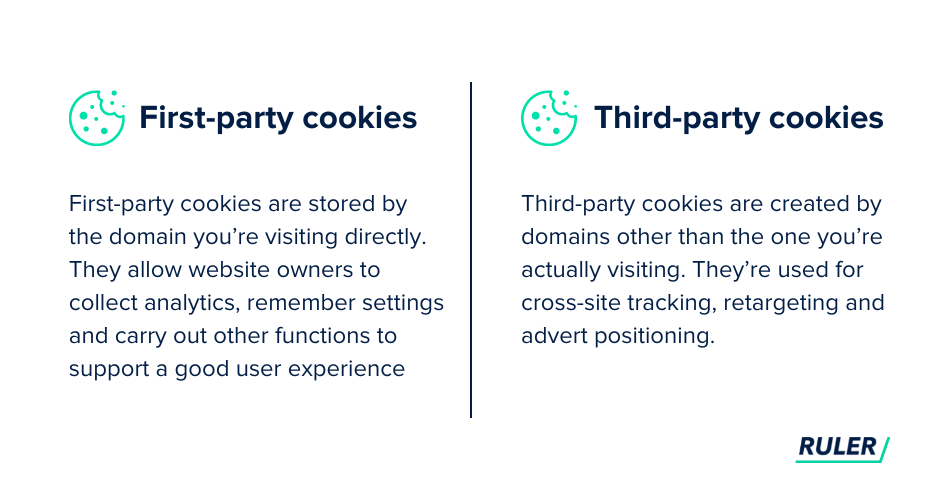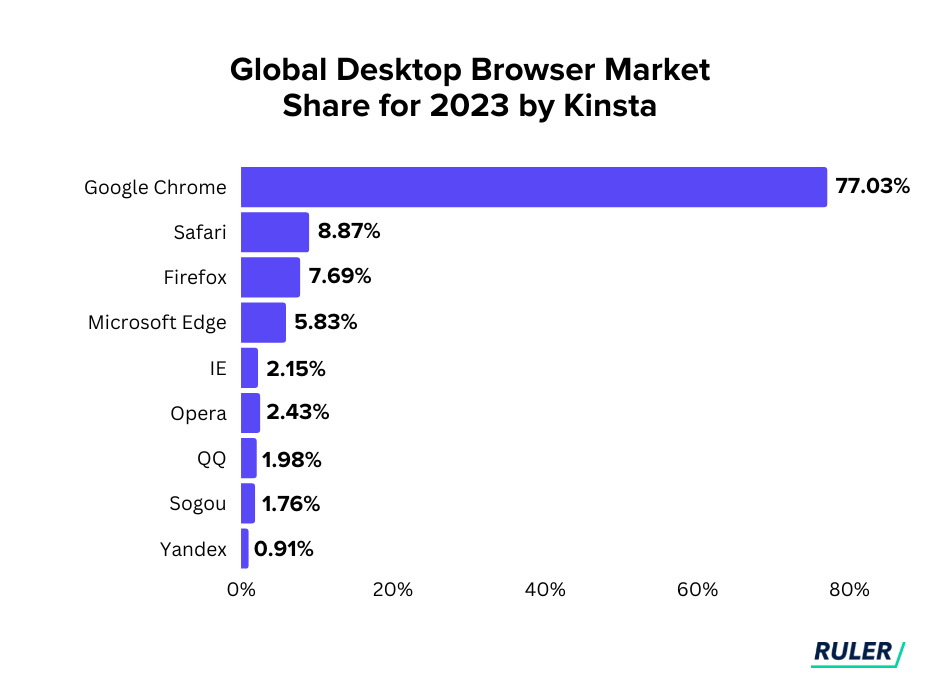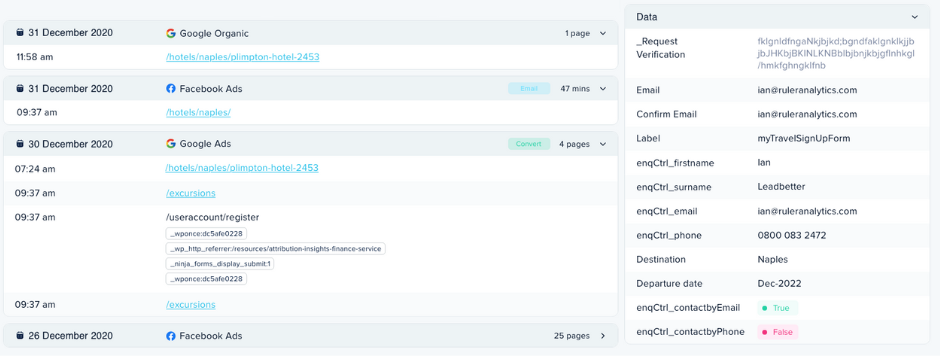Wondering about the future of third-party cookies? With Google announcing changes we explore how marketers can best plan for the third-party cookie apocalypse.
The launch of Apple’s iOS 14.5 update and Google’s third-party cookie phase out has made traditional multi-touch attribution less effective. Here at Ruler, we’re on a journey to combine multi-touch attribution and marketing mix modeling (MMM) to create a more effective approach to marketing measurement. Book a demo to learn more.
Third-party cookies have been a staple of digital advertising for decades, but their time is coming to an end.
Google is following in the footsteps of Safari and Firefox by phasing out third-party cookies to better protect user privacy.
For advertisers, this means big changes ahead. Without third-party cookies, advertisers will no longer be able to track users across the web and target them with personalised ads.
So, how can you prepare for a life without third-party cookies? Stick around to find out.
In this blog, we’ll discuss:
💡 TL;DR
– Third-party cookies are cookies that are placed on your device by websites other than the one you are visiting.
– Ad networks like Google Ads use third-party cookies to create user profiles and serve personalised ads based on a user’s browsing history.
– Third-party cookies aren’t the only way to get user data and target the right people. There are also first-party cookies.
– Third-party cookies are increasingly unpopular due to privacy and security concerns. Major web browsers like Firefox and Safari have restricted third-party cookies since 2013, and Google will phase them out in 2024.
– Advertisers are using four main strategies to adapt to the death of third-party cookies: first-party data tracking, contextual advertising, people-based targeting, and alternative measurement approaches.
A third-party cookie is a cookie that is set by a domain that is different from the domain of the website you are currently visiting. They are often used for online advertising purposes and allow marketers to track users’ browsing behaviour across multiple websites.
Let’s say you visit a website to read a news article.
That website might use first-party cookies (we’ll get to these shortly) to remember your preferences or to track your activity on their website.
It may also contain third-party cookies from advertisers or analytics tools that are embedded on the page.
These third-party cookies can then track your activity across other websites that also use the same advertiser or analytics tool.
Some common examples of third-party cookies include:
Third-party cookies aren’t the only way to get user data and target the right people. There are also first-party cookies.

First-party cookies are created by the website that the user is visiting, and are used to remember user preferences and to improve the user experience on the site.
From a technical perspective, there’s not any major difference between the two types of tracking cookies.
Both cookies contain the same pieces of information and can perform similar functions. The real difference between these two cookie types is how they’re created and used. We break it down in the table below.
| Characteristics | First-party cookies | third-party cookies |
| Created by | The website you’re visiting | Websites other than the one you’re visiting |
| Accessible to | Only the website that created it | Any website that loads the third-party server’s code |
| Used for | Remembering user preferences, login information, and other settings; improving the user experience | Tracking users across the web for targeted advertising and other purposes |
| Example | A shopping cart cookie, a language preference cookie, a login cookie | A social media tracking cookie, an advertising cookie, an analytics cookie |
| Browser support | Supported by all browsers | Blocked by Safari and Firefox web browsers. Google to block third-party cookies in 2024. |
Third-party cookies have become increasingly controversial in recent years, due to concerns about privacy and security.
While they have been useful for advertisers, they have also been a source of frustration for many users, who find the idea of being tracked across the web to be intrusive and creepy.
In response to these concerns, major web browsers such as Mozilla Firefox and Safari implemented restrictions on third-party cookies in 2013. And, in 2020, Google announced that it would also be phasing out support for third-party cookies in 2024.
Google’s decision to phase out third-party cookies will significantly disrupt digital advertising. As it stands, Google Chrome, Safari and Firefox take up 94% of the global desktop browser market share.

Once Google pulls the plug on third-party cookies, they will be gone for good. This will create a number of challenges for marketers, including:
The cookie phase-out has forced marketers to rethink their approach towards online tracking and advertising.
While it may pose some challenges in the short term, it also presents an opportunity for marketers to invest in new technologies and strategies to prioritise user privacy and still allow for effective targeting and personalisation.
Here are four ways advertisers are fighting against the third-party cookie apocalypse.
First-party data is the top priority for most marketers.
Remember, Google isn’t phasing out all cookies. It’s third-party cookies we’re waving goodbye to, not first-party cookies.
With first-party data, businesses can navigate the phase-out of third-party cookies by enabling them to establish a more direct and personal relationship with their customers, comply with privacy regulations, and gain greater control over the quality and accuracy of the data they collect.
There a few ways to collect first-party data:
Another way to collect first-party data is to use a tracking tool like Ruler Analytics, which tracks website visitors and their touchpoints and connects them to revenue data, providing insight into which marketing channels and campaigns are generating the most profitable outcomes.

Ruler allows you to create your own first-party cookies directly on your own domain, which means you can track users through every session and engagement. This allows you to track your lead sources and attribute your closed sales back to your marketing.
We have a guide on how Ruler tracks full customer journeys, which tells you everything you need to know.
Contextual targeting is one approach that marketers are using to address the ban on third-party cookies.
With third-party cookies being phased out, contextual targeting offers an alternative way for advertisers to reach their target audience.
By analysing the content of a web page or app, advertisers can determine the topics or themes that are most relevant to their target audience and serve ads accordingly.
For example, let’s say you’re browsing a website about gardening and reading an article about how to plant tomatoes.
The website uses contextual advertising to display ads that are relevant to the content on the page. In this case, you might see ads for gardening tools, tomato seeds, or other gardening-related products.
The website uses technology to scan the text on the page and identify keywords that are relevant to the content. The advertising platform then uses these keywords to display ads that are likely to be of interest to the user.
Contextual targeting has many benefits over third-party cookie-based targeting. Some of these include:
Next up we have people-based targeting.
With the ongoing shift away from third-party cookies, people-based targeting is becoming increasingly important for advertisers.
People-based targeting is a type of ad targeting that relies on first-party data, such as data collected from a company’s own website or mobile app, to identify and target specific individuals with ads.
People-based targeting typically involves the following steps:
Traditional marketing measurement methods, such as those that rely on third-party cookies, are becoming less reliable.
While a first-party data strategy is essential for marketers in the future, it is also important to collect data from other sources to get a complete picture.
No single data source can provide the full truth.
By adopting a multi-measurement approach, marketers can gain a more complete and accurate understanding of their marketing performance, even in the absence of third-party cookies.
Some examples of multi-measurement approaches include:
Multi-touch attribution: great for providing granular insights into individual marketing touchpoints, but relies on click path data.
Marketing mix modelling: Unlike MTA, MMM uses statistical methods to analyse the relationship between marketing inputs (e.g. budgets, online and offline channels) and outputs (e.g. revenue and sales), rather than relying on a sequence of trackable customer actions.
Experimentation/testing: provides marketers with actionable insights into the direct impact of their advertising efforts.
Third-party cookies are coming to an end.
But the ban on third-party cookies isn’t a bad thing.
This shift in data collection has allowed us to rethink how we collect and use data in a more privacy-conscious and user-friendly way.
And by leveraging first-party data and people-based targeting strategies, advertisers can deliver more personalised and relevant ad experiences.
Don’t forget. Ruler makes the process of collecting first-party data a whole lot easier.
You can see how Ruler Analytics works by booking a demo with our team. We’ll show you how Ruler uses first party data to track your website users and closes the gap between your marketing and revenue.
